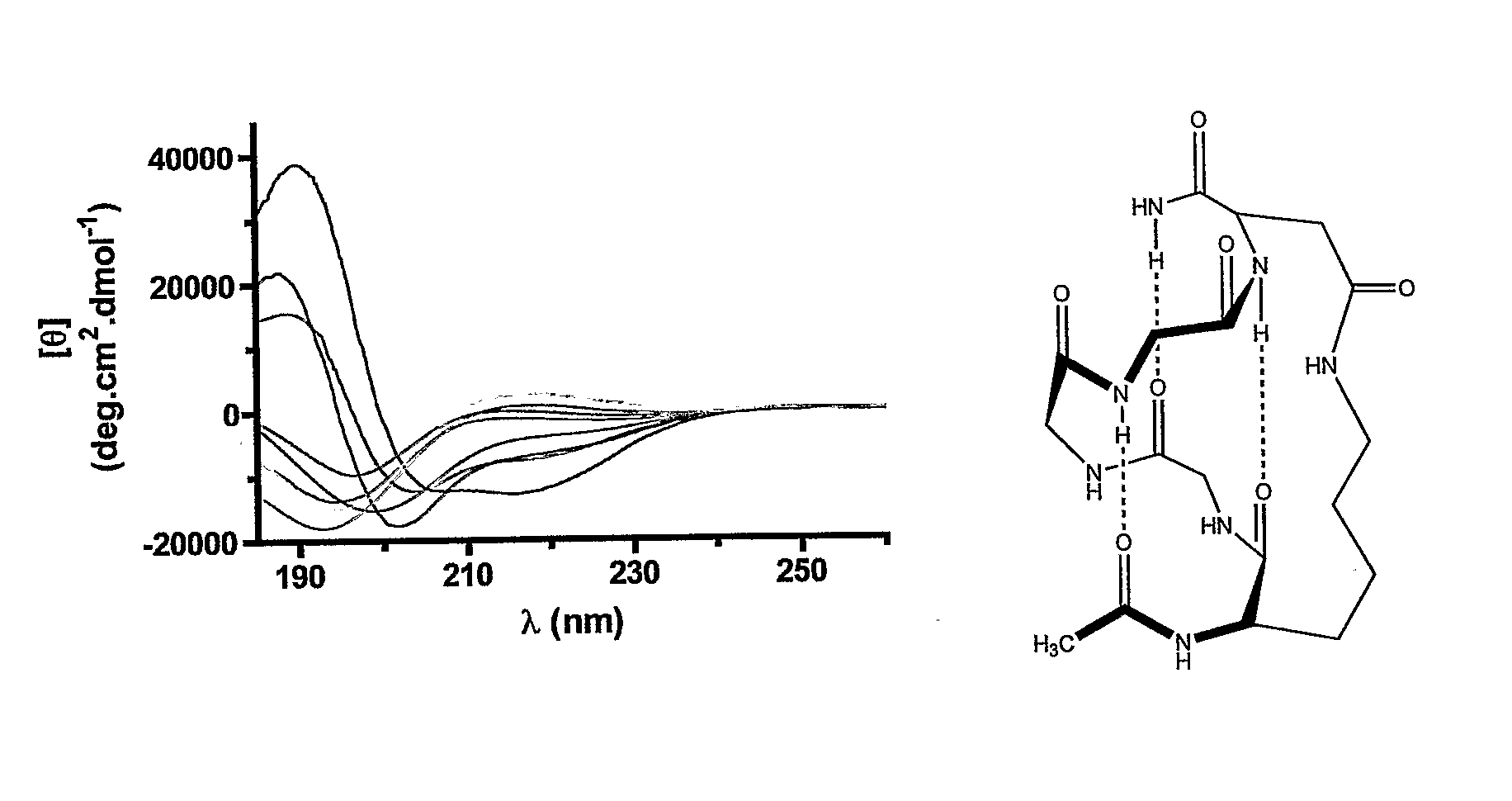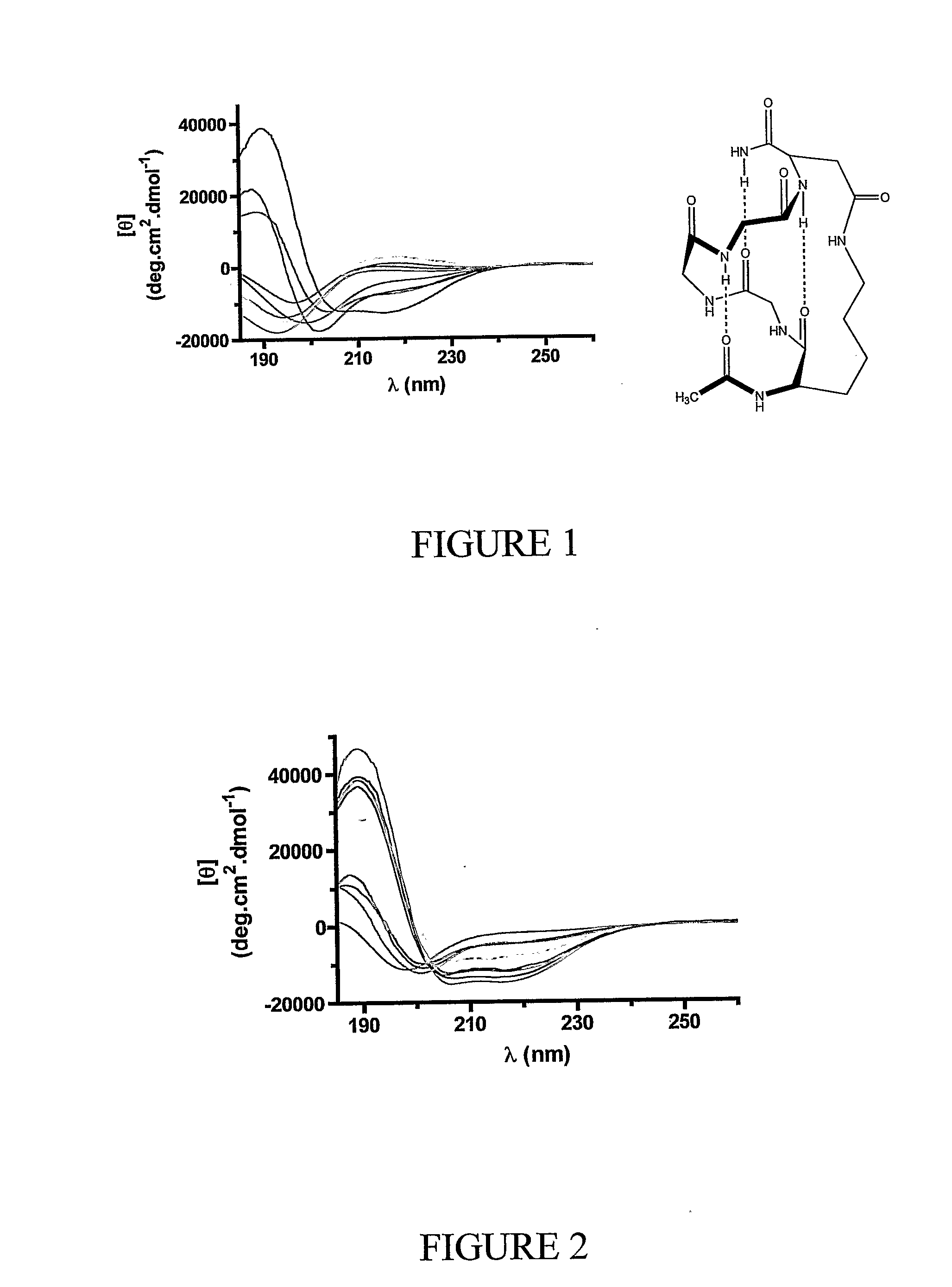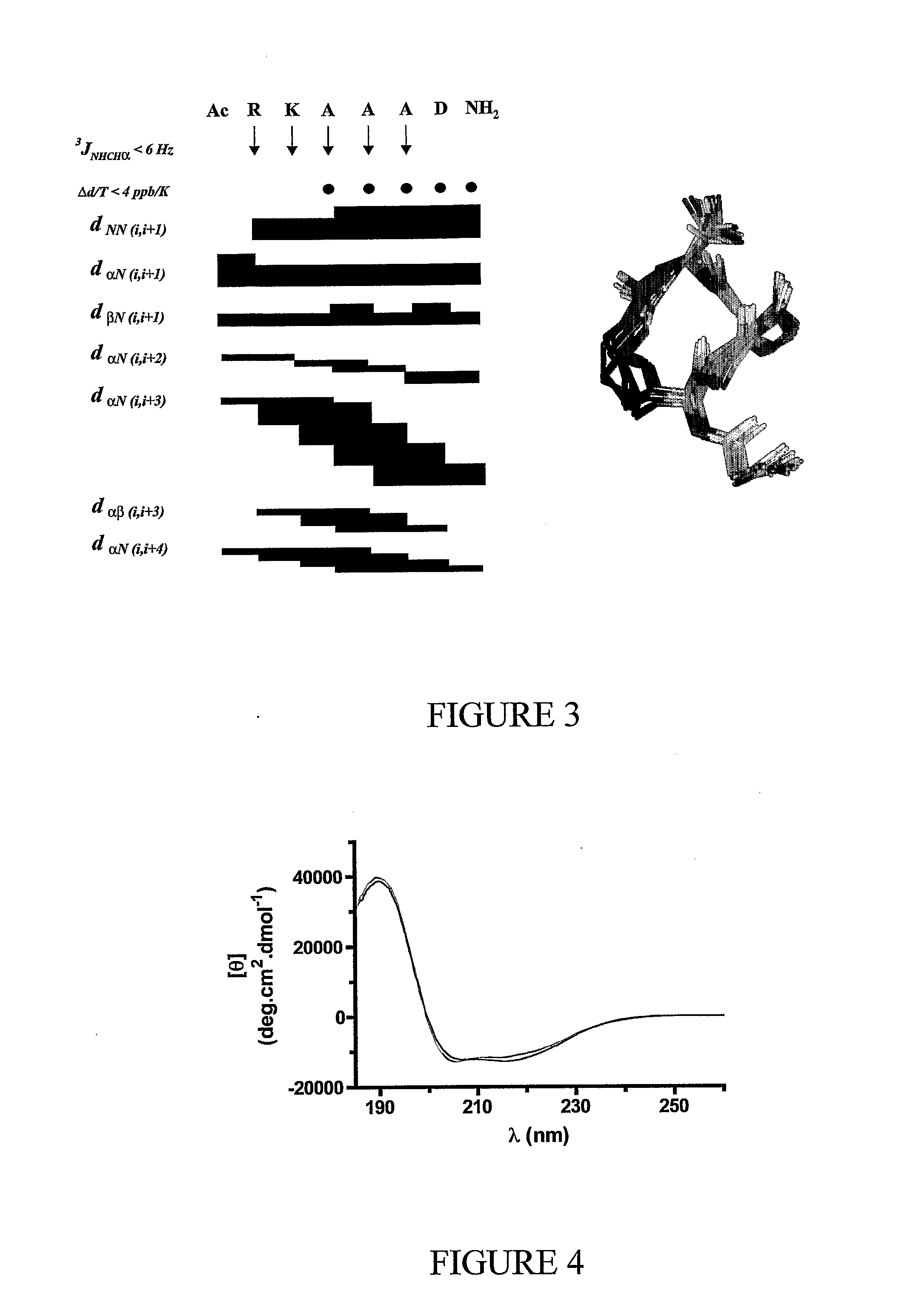[0067]CH3CH2C(O)(CH2)uC(O)—, NH2(NH═)CNHC(O)(CH2)uC(O)—, H2NC(O)(CH2)2C(O)(CH2)uC(O)—, HOC(O)(CH2)2C(O)(CH2)uC(O)—, HS(CH2)2C(O)(CH2)uC(O)—, H2NC(O)(CH2)3C(O)(CH2)uC(O)—, HOC(O)(CH2)2C(O)(CH2)uC(O)—, (4-imidazolyl)(CH2)C(O)(CH2)uC(O)—, CH3CH2CH(CH3)CH2C(O)(CH2)uC(O)—, (CH3)2CH(CH2)2C(O)(CH2)uC(O)—, H2N(CH2)5C(O)(CH2)uC(O)—, CH3S(CH2)3C(O)(CH2)uC(O)—, Ph(CH2)2C(O)(CH2)uC(O)—, Ph(CH2)4C(O)(CH2)uC(O)—, HO(CH2)2C(O)(CH2)uC(O)—, HOCH(CH3)CH2C(O)(CH2)uC(O)—, (3-indolyl)(CH2)2(CH2)uC(O)—, (4-hydroxyphenyl)(CH2)2C(O)(CH2)uC(O)—, (4-hydroxyphenyl)(CH2)3C(O)(CH2)uC(O)—, (CH3)2CHCH2C(O)(CH2)uC(O)—, CH3CH2CH2C(O)(CH2)uC(O)—, C6H10CH2C(O)(CH2)uC(O)—, C5H8CH2C(O)(CH2)uC(O)—, CH3C(O)(CH2)uC(O)—, CH3(CH2)4C(O)(CH2)uC(O)—, CH3(CH2)5C(O)(CH2)uC(O)—, HOC(O)CH2C(O)(CH2)uC(O)—, HS(CH2)C(O)(CH2)uC(O)—, H2N(CH2)4C(O)(CH2)uC(O)— and HOCH2C(O)(CH2)uC(O)— wherein u is 0 or an integer from 1 to 10. The preferred non-peptidic groups enhance the stability,
bioavailability or activity of the peptides. Suitable non-peptidic groups include, but are not limited to hydrophobic groups such as carbobenzoxyl, dansyl, t-butyloxycarbonyl, acetyl, 9-fluorenylmethoxycarbonyl, groups which stabilize or mimic alpha-helices, groups which mimic the secondary structure of peptides, particularly alpha helical peptides, such as those disclosed in WO 03 / 018587, groups which improve
bioavailability, such as hydrophilic groups which aid
aqueous solubility, for example, cyclodextrans; groups which are recognized by transport receptors to allow or improve transport of the peptides to the site of activity, for example, transport across
cell walls or through an epithelial layer such as
skin or the gut wall.
[0071]In some embodiments, non-peptidic groups enhance the stability and circulating time, or decrease
immunogenicity, or increase
solubility,
bioavailability or activity of the peptides (see U.S. Pat. No. 4,179,337). Suitable non-peptidic groups include but are not limited to hydrophobic groups such as t-butyl, groups which stabilize or mimic alpha-helices, groups which mimic the secondary structure of peptides, particularly alpha helical peptides, such as those disclosed in WO 03 / 018587, groups which improve bioavailability, such as hydrophilic groups which aid
aqueous solubility, for example, cyclodextrans; groups which are recognized by transport receptors to allow or improve transport of the peptides to the site of activity, for example, transport across
cell walls or through an epithelial layer such as
skin or the gut wall. In some embodiments, PEG (
polyethylene glycol) groups are conjugated to the
peptide compounds to make those compounds more easily formulated and orally available. The amphiphilic nature of PEG helps protect the parent
peptide from enzymatic breakdown and positions the
drug for absorption across the
gastrointestinal tract into the
plasma. The terms “pegylated” and “
pegylation” refer to the process of reacting a poly(alkylene glycol), suitably an activated poly(alkylene glycol), with a facilitator such as an
amino acid, e.g.
lysine, to form a
covalent bond. Although “
pegylation” is often carried out using poly(
ethylene glycol) or derivatives thereof, such as methoxy poly(
ethylene glycol), the term is not intended to be so limited here, but is intended to include any other useful poly(alkylene glycol), such as, for example poly(
propylene glycol). The chemical moieties for derivitization may also be selected from
water soluble polymers such as
polyethylene glycol,
ethylene glycol /
propylene glycol copolymers, carboxymethylcellulose,
dextran,
polyvinyl alcohol and the like. The pentapeptide compounds may be modified at random positions within the molecule, or at predetermined positions within the molecule and may include one, two, three or more attached chemical moieties. In some embodiments, the modification occurs at a position outside of the cyclic pentapeptide
moiety, for example at amino acids preceding the cyclic pentapeptide
moiety or at the N-terminus.
[0149](CH3)2CH(CH2)2C(O)(CH2)uC(O)—, H2N(CH2)5C(O)(CH2)uC(O)—, CH3S(CH2)3C(O)(CH2)uC(O)—, Ph(CH2)2C(O)(CH2)uC(O)—, Ph(CH2)4C(O)(CH2)uC(O)—, HO(CH2)2C(O)(CH2)uC(O)—, HOCH(CH3)CH2C(O)(CH2)uC(O)—, (3-indolyl)(CH2)2(CH2)uC(O)—, (4-hydroxyphenyl)(CH2)2C(O)(CH2)uC(O)—, (4-hydroxyphenyl)(CH2)3C(O)(CH2)uC(O)—, (CH3)2CHCH2C(O)(CH2)uC(O)—, CH3CH2CH2C(O)(CH2)3C(O)—, C6H10CH2C(O)(CH2)uC(O)—, C5H8CH2C(O)(CH2)uC(O)—, CH3C(O)(CH2)uC(O)—, CH3(CH2)4C(O)(CH2)uC(O)—, CH3(CH2)5C(O)(CH2)uC(O)—, HOC(O)CH2C(O)(CH2)uC(O)—, HS(CH2)C(O)(CH2)uC(O)—, H2N(CH2)4C(O)(CH2)uC(O)— and HOCH2C(O)(CH2)uC(O)— wherein u is 0 or an integer from 1 to 10. The preferred non-peptidic groups enhance the stability, bioavailability or activity of the peptides. Suitable non-peptidic groups include, but are not limited to hydrophobic groups such as carbobenzoxyl, dansyl, t-butyloxycarbonyl, acetyl, 9-fluorenylmethoxycarbonyl, groups which stabilize or mimic alpha-helices, groups which mimic the secondary structure of peptides, particularly alpha helical peptides, such as those disclosed in WO 03 / 018587, groups which improve bioavailability, such as hydrophilic groups which aid
aqueous solubility, for example, cyclodextrans; groups which are recognized by transport receptors to allow or improve transport of the peptides to the site of activity, for example, transport across
cell walls or through an epithelial layer such as
skin or the gut wall;
[0153]The preferred non-peptidic groups enhance the stability, bioavailability or activity of the peptides. Suitable non-peptidic groups include but are not limited to hydrophobic groups such as t-butyl, groups which stabilize or mimic alpha-helices, groups which mimic the secondary structure of peptides, particularly alpha helical peptides, such as those disclosed in WO 03 / 018587, groups which improve bioavailability, such as hydrophilic groups which aid aqueous
solubility, for example, cyclodextrans; groups which are recognized by transport receptors to allow or improve transport of the peptides to the site of activity, for example, transport across cell walls or through an epithelial layer such as skin or the gut wall;
[0168]Alternatively, a single cyclic macrocyclic module may be prepared using
solid phase synthesis as hereinbefore described. The single macrocyclic module may be cleaved from the resin and undergo either N-terminal protection or deprotection or C-terminal protection or deprotection. A macrocycle having N-terminal protection and a macrocycle having C-terminal protection may then be reacted with one another by activating the unprotected
carboxylic acid to nucleophilic
attack by the unprotected amine
nitrogen, to provide a multi-macrocyclic structure. Further N-terminal and / or C-terminal protection and deprotection of a single macrocyclic module and a multi-macrocyclic module followed by
coupling will allow the preparation of a multi-
macrocyclic peptide.
[0171]The helically constrained peptides described herein can be synthesized with additional
chemical groups present at their amino and / or carboxy termini, such that, for example, the stability, bioavailability, and / or inhibitory activity of the peptides is enhanced. For example, hydrophobic groups such as carbobenzoxyl, dansyl, or t-butyloxycarbonyl groups, may be added to the amino termini. An acetyl group or a 9-fluorenylmethoxy-
carbonyl group may be placed at the amino termini. A hydrophobic group, t-butyloxycarbonyl, or an amido group may be added to carboxy termini. Furthermore, the peptides of the invention can be synthesized such that their steric configuration is altered. For example, the D-isomer of one or more of the amino acid residues of the
peptide can be used, rather than the usual L-isomer. The compounds can contain at least one bond linking adjacent amino acids that is a non-
peptide bond, and is preferably not
helix breaking. Non-peptide bonds for use in flanking sequences include an imino, ester, hydrazine,
semicarbazide,
oxime, or azo bond. Still further, at least one of the amino acid residues of the peptides of the invention can be substituted by one of the well known non-naturally occurring amino acid residues, that is preferably not
helix breaking. Desirably, the non-natural amino acid or non-
amide bond linking adjacent amino acids, when present, is present outside of the internal sequence, and is, preferably, not
helix breaking. Still further, at least one of the amino acid residues of the peptides of the invention can be substituted by one of the well known non-naturally occurring amino acid residues. Alterations such as these can serve to increase the stability, bioavailability,
immunogenicity, and / or inhibitory action of the peptides of the invention.
 Login to View More
Login to View More 


